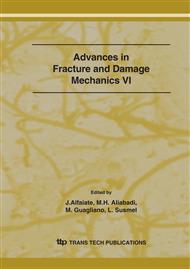p.73
p.77
p.81
p.85
p.89
p.93
p.97
p.101
p.105
A New Correction Procedure to Correct the Predicted Crack Extension Direction of a Mixed Mode Crack Path
Abstract:
In an incremental crack extension analysis each crack increment is in general modelled with a straight extension. In order to avoid introduction of an error when the local crack growth criterion is used with an incremental formulation, each straight crack extension would have to be infinitesimal as the crack growth direction changes when the crack grows. A correction procedure to correct the extension direction of the increment can however be applied to ensure that a unique crack path is achieved with different analyses of the same problem performed with different size of the crack-extension increments. A proposed correction procedure and an reference correction procedure are demonstrated by solving a computational crack growth example. The demonstration shows that analyses of the crack path performed with big crack extensions and the proposed crack correction procedure are in excellent agreement with analyses of the crack path performed with very small crack extensions. Furthermore it is shown that the reference correction procedure has a tendency to overcorrect the crack growth direction if the stop criterion for the iterative correction procedure is not specified for each new crack growth analysis.
Info:
Periodical:
Pages:
89-92
Citation:
Online since:
September 2007
Authors:
Price:
Сopyright:
© 2007 Trans Tech Publications Ltd. All Rights Reserved
Share:
Citation:


